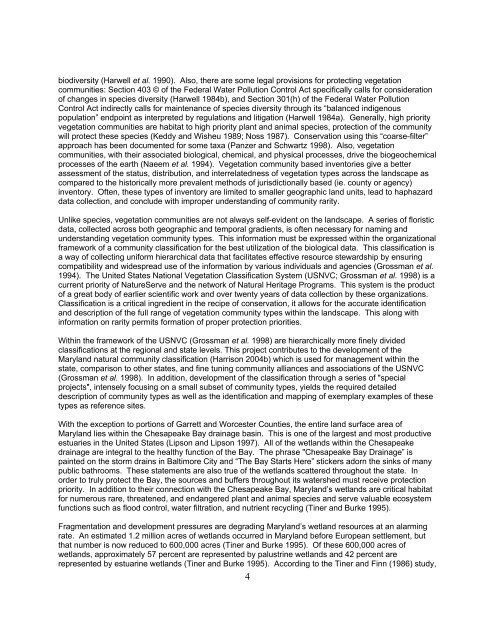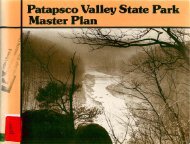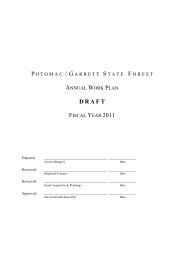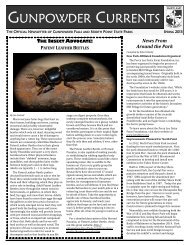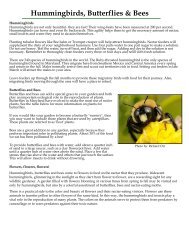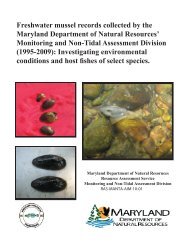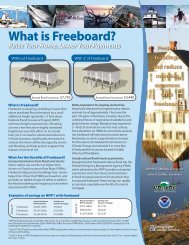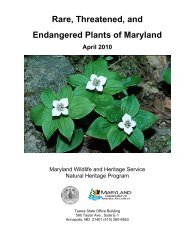tidal hardwood swamps - Maryland Department of Natural Resources
tidal hardwood swamps - Maryland Department of Natural Resources
tidal hardwood swamps - Maryland Department of Natural Resources
Create successful ePaper yourself
Turn your PDF publications into a flip-book with our unique Google optimized e-Paper software.
iodiversity (Harwell et al. 1990). Also, there are some legal provisions for protecting vegetation<br />
communities: Section 403 © <strong>of</strong> the Federal Water Pollution Control Act specifically calls for consideration<br />
<strong>of</strong> changes in species diversity (Harwell 1984b), and Section 301(h) <strong>of</strong> the Federal Water Pollution<br />
Control Act indirectly calls for maintenance <strong>of</strong> species diversity through its “balanced indigenous<br />
population” endpoint as interpreted by regulations and litigation (Harwell 1984a). Generally, high priority<br />
vegetation communities are habitat to high priority plant and animal species, protection <strong>of</strong> the community<br />
will protect these species (Keddy and Wisheu 1989; Noss 1987). Conservation using this “coarse-filter”<br />
approach has been documented for some taxa (Panzer and Schwartz 1998). Also, vegetation<br />
communities, with their associated biological, chemical, and physical processes, drive the biogeochemical<br />
processes <strong>of</strong> the earth (Naeem et al. 1994). Vegetation community based inventories give a better<br />
assessment <strong>of</strong> the status, distribution, and interrelatedness <strong>of</strong> vegetation types across the landscape as<br />
compared to the historically more prevalent methods <strong>of</strong> jurisdictionally based (ie. county or agency)<br />
inventory. Often, these types <strong>of</strong> inventory are limited to smaller geographic land units, lead to haphazard<br />
data collection, and conclude with improper understanding <strong>of</strong> community rarity.<br />
Unlike species, vegetation communities are not always self-evident on the landscape. A series <strong>of</strong> floristic<br />
data, collected across both geographic and temporal gradients, is <strong>of</strong>ten necessary for naming and<br />
understanding vegetation community types. This information must be expressed within the organizational<br />
framework <strong>of</strong> a community classification for the best utilization <strong>of</strong> the biological data. This classification is<br />
a way <strong>of</strong> collecting uniform hierarchical data that facilitates effective resource stewardship by ensuring<br />
compatibility and widespread use <strong>of</strong> the information by various individuals and agencies (Grossman et al.<br />
1994). The United States National Vegetation Classification System (USNVC; Grossman et al. 1998) is a<br />
current priority <strong>of</strong> NatureServe and the network <strong>of</strong> <strong>Natural</strong> Heritage Programs. This system is the product<br />
<strong>of</strong> a great body <strong>of</strong> earlier scientific work and over twenty years <strong>of</strong> data collection by these organizations.<br />
Classification is a critical ingredient in the recipe <strong>of</strong> conservation, it allows for the accurate identification<br />
and description <strong>of</strong> the full range <strong>of</strong> vegetation community types within the landscape. This along with<br />
information on rarity permits formation <strong>of</strong> proper protection priorities.<br />
Within the framework <strong>of</strong> the USNVC (Grossman et al. 1998) are hierarchically more finely divided<br />
classifications at the regional and state levels. This project contributes to the development <strong>of</strong> the<br />
<strong>Maryland</strong> natural community classification (Harrison 2004b) which is used for management within the<br />
state, comparison to other states, and fine tuning community alliances and associations <strong>of</strong> the USNVC<br />
(Grossman et al. 1998). In addition, development <strong>of</strong> the classification through a series <strong>of</strong> "special<br />
projects", intensely focusing on a small subset <strong>of</strong> community types, yields the required detailed<br />
description <strong>of</strong> community types as well as the identification and mapping <strong>of</strong> exemplary examples <strong>of</strong> these<br />
types as reference sites.<br />
With the exception to portions <strong>of</strong> Garrett and Worcester Counties, the entire land surface area <strong>of</strong><br />
<strong>Maryland</strong> lies within the Chesapeake Bay drainage basin. This is one <strong>of</strong> the largest and most productive<br />
estuaries in the United States (Lipson and Lipson 1997). All <strong>of</strong> the wetlands within the Chesapeake<br />
drainage are integral to the healthy function <strong>of</strong> the Bay. The phrase "Chesapeake Bay Drainage” is<br />
painted on the storm drains in Baltimore City and “The Bay Starts Here” stickers adorn the sinks <strong>of</strong> many<br />
public bathrooms. These statements are also true <strong>of</strong> the wetlands scattered throughout the state. In<br />
order to truly protect the Bay, the sources and buffers throughout its watershed must receive protection<br />
priority. In addition to their connection with the Chesapeake Bay, <strong>Maryland</strong>’s wetlands are critical habitat<br />
for numerous rare, threatened, and endangered plant and animal species and serve valuable ecosystem<br />
functions such as flood control, water filtration, and nutrient recycling (Tiner and Burke 1995).<br />
Fragmentation and development pressures are degrading <strong>Maryland</strong>’s wetland resources at an alarming<br />
rate. An estimated 1.2 million acres <strong>of</strong> wetlands occurred in <strong>Maryland</strong> before European settlement, but<br />
that number is now reduced to 600,000 acres (Tiner and Burke 1995). Of these 600,000 acres <strong>of</strong><br />
wetlands, approximately 57 percent are represented by palustrine wetlands and 42 percent are<br />
represented by estuarine wetlands (Tiner and Burke 1995). According to the Tiner and Finn (1986) study,<br />
4


